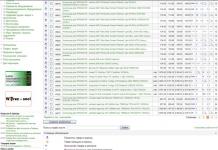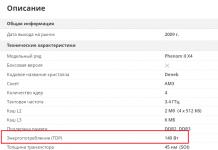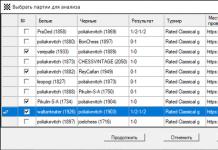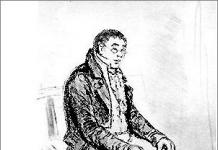Criteria for assessing the skills of primary school students
(English)
When teaching English language children 9-10 years old hardly need to talk about the direct control of educational actions, pronunciation, grammatical, lexical skills, as well as speech skills of students. At the same time, classes in a foreign language, as well as in any general education subject included in the schedule of hours primary school, should be assessed at some fixed intervals of study time (quarters, semesters, years). When studying the course, it is assumed that 3 types of control will be carried out:current: During the current control, no emphasis is placed on the control lesson, and the ZUN check is carried out in a playful, unobtrusive manner. (ZUN control on vocabulary, grammar, spelling);midterm: (listening, reading, speaking or writing at the end of the quarter);
final: An important condition control and assessment of the speech skills of students is also the observance of the following condition: the nature of the tasks offered as control, must be well known to the students. (control of all types of speech activity at the end of the academic year). The results of verification (control) work are evaluated on a five-point scale.
Criteria for assessing the skills and abilities of grade 3 students
Speaking Assessment Criteria Monologue
Assessment Response characteristics
The student logically builds a monologue statement (description, story) in accordance with the communicative task formulated in the assignment. Lexical units and grammatical structures are used appropriately. There are practically no errors. The student's speech is understandable: almost all sounds in the speech stream are pronounced correctly, the correct intonation pattern is observed. The volume of the utterance is at least 5 phrases
The student logically builds a monologue statement (description, story) in accordance with the communicative task formulated in the assignment. The lexical units and grammatical structures used correspond to the set communicative task. The student makes some lexical and grammatical mistakes that do not interfere with the understanding of his speech. The student's speech is understandable, the student does not make phonemic mistakes. The volume of the utterance is at least 5 phrases
The student builds a monologue statement (description, story) in accordance with the communicative task formulated in the assignment. But: - the utterance is not always logical, there are repetitions, - lexical and grammatical mistakes are made that make it difficult to understand. The respondent's speech is generally understandable, the student mainly observes the intonation pattern. The volume of the utterance is less than 5 phrases
The communicative task has not been completed. The content of the answer does not correspond to the communicative task set in the task. Numerous lexical and grammatical errors are made that make it difficult to understand. Speech is poorly perceived by ear due to the large number of phonemic errors.
Dialogue form Assessment Characteristic of the answer
The student logically builds dialogical communication in accordance with the communicative task. The student demonstrates the skills and abilities of verbal interaction with a partner: he is able to start, support and end a conversation. The language material used corresponds to the supplied KZ. There are practically no lexical and grammatical errors.
The student's speech is understandable: he does not make phonemic mistakes, he pronounces almost all sounds in the stream of speech correctly, observes the correct intonation pattern. The volume of the statement is at least 3-4 remarks on each side. 4 The student logically builds dialogical communication in accordance with the communicative task. The student as a whole demonstrates the skills and abilities of language interaction with a partner: he is able to start, support and end a conversation. Used vocabulary and the grammatical structures correspond to the set KZ. Some lexical errors may be made that do not hinder understanding. The speech is clear: there are no phonemic errors, practically all sounds in the speech stream are pronounced correctly, basically observes the correct intonation pattern. The volume of the statement is less than given: 3-4 replicas on each side. 3 The student logically builds a dialogue in accordance with the KZ. However, he does not seek to maintain the conversation. The used LE and GS correspond to the supplied short circuit. Phonemic, lexical and grammatical errors do not impede communication. But: - there are violations in the use of vocabulary, - some gross grammatical mistakes are made. Common and simple words are not pronounced correctly. The volume of the statement is less than given: 3-4 replicas on each side. 2 short circuit not executed. The student does not know how to build dialogical communication, cannot maintain a conversation. An extremely limited vocabulary is used, numerous lexical and grammatical errors are made, which make it difficult to understand. Speech is poorly perceived by ear due to the large number of phonemic errors. Student Reading Assessment Criteria
Rating Reading Characteristics
He is fluent in reading rules, practically does not make mistakes. The pace of reading is fluent, natural (close to natural). He makes minor mistakes and easily corrects them himself. Demonstrates mastery of all the learned reading rules. The student fully understood the content of the text and completed all the tasks for the texts.
He has a good command of the reading technique, makes 2-4 mistakes within the studied material, which do not interfere with the general understanding of the reading, and he can correct them himself. Reading at a steady pace, with small pauses. The student understood the content of the text, excluding the details and having completed 2/3 of the tasks to the text.
The rate of speech is low, with noticeable pauses. Uses simple speech models. She makes a lot of mistakes, sometimes preventing her reading comprehension. The student understood only the main content of the text and completed 1/3 of the tasks to the text
A large number of gross errors that often impede understanding of the meaning of what has been read. The reading rate is low. Does not know the rules of reading, makes a large number of gross errors that impede reading comprehension. The reading pace is very slow.
Student Listening Assessment Criteria
Assessment Characteristics of responses
The students fully understood the content of the text by ear and completed all the tasks in the text. Complete understanding (90-100%) The maximum allowable number of semantic errors (distortion, omission, addition of information) when answering questions to the listened text - 1. The maximum number of grammatical errors - 1.
The students understood the content of the text without details by ear and completed 2/3 of the tasks. More than 70% of the content is understood. The maximum permissible number of semantic errors (distortion, omission, addition of information) when answering questions to the listened text is 2. The maximum number of grammatical errors is 2.
The students understood only the main meaning of the text by ear with a slight distortion of the details of the content and completed 1/3 of the tasks. More than 50% of the content is understood. The maximum allowable number of semantic errors (distortion, omission, addition of information) when answering questions to the listened text is 2. The maximum number of grammatical errors is 4.
The students did not understand the content of the text and did not complete the tasks in the text correctly. Less than 50% of the content is understood. The maximum allowable number of semantic errors when answering questions about the text heard is more than 3. The maximum number of grammatical errors is 5.
Criteria for evaluating student writing
Mark The volume of correctly completed tasks (in% of the total work volume) 5 Exceeds 75% The student has completed 4 tasks grammatically correctly. 4 Does not exceed 65-75% The student has completed 3 tasks, making 2-3 grammatical mistakes. 3 Does not exceed 50% -65% The student made 4-5 grammatical mistakes and completed 1 task. 2 Does not exceed 25% The student did not complete any assignment correctly.
2015
Criteria for assessing the tasks of the oral part of the exam in foreign languages
Task 2 (maximum - 5 points).
Each of the five questions asked is assessed separately.
Tasks 3 and 4 (description of a photo and comparison of two photos) - 7 points for one task (maximum - 14 points).
| Points | Solution of a communication problem (content) * | Organization of utterances | Language design of the statement |
| The communicative task is completed in full: the content fully, accurately and in detail reflects all the aspects specified in the assignment (12-15 phrases) | |||
| The communicative task is partially completed: one aspect is not disclosed (the rest are fully disclosed), OR one or two are disclosed incompletely (9-11 phrases) | The statement is logical and complete; there are introductory and closing phrases corresponding to the topic. Logic communication tools are used correctly | The vocabulary used, grammatical structures, phonetic design of the utterance correspond to the task at hand (no more than two crude lexical and grammatical errors are allowed AND / OR no more than two crude phonetic errors) | |
| The communicative task is not fully completed: two aspects are not disclosed (the rest are fully disclosed), OR all aspects are incompletely disclosed (6-8 phrases) | The statement is mostly logical and has a rather complete character, BUT there is no introductory AND / OR final phrase, AND / OR means of logical connection are not used enough | The vocabulary used, grammatical structures, phonetic design of the statement basically correspond to the task at hand (no more than four lexical and grammatical errors are allowed (of which no more than two gross) OR / AND no more than four phonetic errors (of which no more than two gross) | |
| The communicative task is completed by less than 50%: three or more aspects of the content are not disclosed (5 or less phrases) | The statement is illogical AND / OR is not complete; there are no introductory and closing phrases; logical communication means are practically not used | Understanding the statement is difficult due to numerous lexical-grammatical and phonetic errors (five or more lexical-grammatical errors AND / OR five or more phonetic errors) OR more than two gross errors |
*Note. When the examinee receives 0 points according to the criterion "Solution of a communication problem", the entire task is evaluated at 0 points.
APPENDIX 4.
English. The oral part. Additional grading scheme for assignment 1 "Reading text aloud"
English. The oral part. Additional grading scheme for assignment 2 (conditional questioning dialogue).
Expert's full name _____________________________ Expert code ____________________
| FORM NUMBER | |||||||||||
| Holistic assessment | Question 1 in terms of content meets the task; has the correct grammatical form of a direct question; possible phonetic and lexical errors do not impede perception | ||||||||||
| Question 2 answers the task in terms of content; has the correct grammatical form of a direct question; possible phonetic and lexical errors do not impede perception | |||||||||||
| Question 3 meets the task in terms of content; has the correct grammatical form of a direct question; possible phonetic and lexical errors do not impede perception | |||||||||||
| Question 4 answers the task in terms of content; has the correct grammatical form of a direct question; possible phonetic and lexical errors do not impede perception | |||||||||||
| Question 5 in terms of content meets the task at hand; has the correct grammatical form of a direct question; possible phonetic and lexical errors do not impede perception | |||||||||||
| FINAL SCORE (maximum score - 5) |
English. The oral part. Additional assessment scheme for assignment 3 (photo description).
Expert's full name _____________________________ Expert code ____________________
| FORM NUMBER | |||||||||||
| Aspect 1. The answer to the question when the photo was taken is given | |||||||||||
| Aspect 2: The answer to the question of who / what is shown in the photo is given | |||||||||||
| Aspect 3: The answer to the question of what happens in the photo is given | |||||||||||
| Aspect 4: The answer to the question why the author took this photo is given | |||||||||||
| Aspect 5: The answer to the question why the author decided to show this photo to a friend is given | |||||||||||
| 2. Organization | Presence of an introduction and conclusion, completeness of the statement | ||||||||||
| 3. |
English. The oral part. Additional grading scheme for task 4 (comparison of two photos).
Expert's full name _____________________________ Expert code ____________________
| FORM NUMBER | |||||||||||
| 1. Solution of a communication problem (Contents) | Aspect 1. Short description photos (what happens in the photo and where) given | ||||||||||
| Aspect 2: The answer to the question about the similarity of photographs is given | |||||||||||
| Aspect 3: The answer to the difference question is given | |||||||||||
| Aspect 4: The answer to the question about the preferences of the examinee is given | |||||||||||
| Aspect 5: Justification of your preferences given | |||||||||||
| FINAL SCORE (maximum score - 3) | |||||||||||
| 2. Organization | Presence of an introduction and conclusion, completeness of the statement | ||||||||||
| Consistency and use of logical communication means | |||||||||||
| FINAL SCORE (maximum score - 2) | |||||||||||
| 3. | LANGUAGE DESIGN OF STATEMENT (maximum score - 2) |
Communicative competence and its components are interpreted somewhat differently in foreign and domestic methodological tradition different scientific and practical schools, which, nevertheless, mostly agree in its linguo-methodical description. Detailed comparative analysis see: V.V. Safonova Communicative competence: modern approaches to multilevel description for methodological purposes. - M .: Evroshkola, 2004.
Federal component of the state educational standard of secondary (complete) general education in foreign languages. // New state standards in a foreign language. 2-11 grades. / Education in documents and comments. - M .: AST. Astrel, 2004. p. 93.
Federal component of state educational standards of primary general, basic general and secondary (complete) general education, 2004.
See Verbitskaya M.The. Verification of oral speech skills at the unified state exam in a foreign language. - .. Federal Institute of Pedagogical Measurements: Collection of articles for the fifth anniversary of the institute / ed. A.G. Ershova, G.S. Kovaleva. - M., EKSMO, 2007.S. 98-107.
GEF 2012
Solovova E.N., Rodomanchenko A.S. Forms of control of monologic skills in international examinations in English .- // Foreign languages at school, 2013, No. 2, pp. 39-46.
The first digit denotes the number of the task by numbering the tasks of the oral part of the Unified State Exam in foreign languages, i.e. task 1 - reading the text aloud, task 2 - questions; task 3 - description of the photo, task 4 - comparison of two photographs. The second number denotes a specific option.
The third digit conventionally denotes the student's specific answer being analyzed.
FOREIGN LANGUAGE ASSESSMENT CRITERIA (ENGLISH)
Speaking:
- monologue
"5" - the student logically builds a monologue statement (description, story) in accordance with the communicative task formulated in the task. Lexical units and grammatical structures are used appropriately. There are practically no errors. The student's speech is clear: almost all sounds are pronounced correctly,
the correct intonation is observed.
"4" - the student logically builds a monologue statement (description, story) in accordance with the communicative task formulated in the task. The lexical units and grammatical structures used correspond to the set communicative task. The student makes some lexical or grammatical mistakes that do not interfere with the understanding of his speech. The student's speech is clear, the student does not make phonemic mistakes.
"3" - the student logically builds a monologue statement in accordance with the communicative task formulated in the task. But the statement is not always logical, there are repetitions. Vocabulary and grammatical errors are made that make it difficult to understand. The speech is generally clear, the student generally observes the correct intonation.
"2" - the communication task has not been completed. Numerous lexical and grammatical errors are made that make it difficult to understand. A large number of phonemic errors.
- dialogical form
"5" - the student logically builds dialogical communication in accordance with the communicative task; demonstrates the skills of verbal interaction with a partner: is able to start, support and end a conversation. Lexical units and grammatical structures correspond to the set communicative task. There are practically no errors. The speech is clear: almost all sounds are pronounced correctly, the correct intonation is observed.
"4" - the student logically builds dialogical communication in accordance with the communicative task; generally demonstrates the skills of verbal interaction with a partner:
able to start, maintain and end a conversation. The vocabulary and grammatical structures used correspond to the set communicative task. Some lexical and grammatical errors may be made that do not impede understanding.
The speech is clear: almost all sounds are pronounced correctly, basically the correct intonation is observed.
"3" - the student logically builds dialogical communication in accordance with the communicative task. However, the student does not seek to maintain a conversation. The lexical units and grammatical structures used correspond to the set communicative task. Phonemic, vocabulary and grammatical errors do not make it difficult
communication. But there are violations in the use of vocabulary. Some gross grammatical mistakes are made.
"2" - the communication task has not been completed. The student does not know how to build dialogical communication, cannot maintain a conversation. An extremely limited vocabulary is used, numerous lexical and grammatical errors are made, which make it difficult to understand. A large number of phonemic errors.
Note: at the end of the oral answer, a brief analysis of the answer is given, a motivated assessment is announced. It is possible to attract other students to analyze the answer, introspection, offer an assessment.
Listening:
« 5 »- the communicative task is solved and at the same time the student fully understands the content of the foreign language speech that meets the program requirements for each class.
« 4 »- the communicative task is solved and at the same time the student understood the content of the foreign language speech that meets the program requirements for the given class, with the exception of certain details that do not affect the understanding of the content of what he heard as a whole.
« 3 »- the communicative task has been solved and the students have understood only the main meaning of the foreign language speech, which corresponds to the program requirements for the given class.
« 2 "- the student did not understand the meaning of the foreign language speech that meets the program requirements for this class.
Reading:
« 5 »- the communicative task is solved and at the same time the student fully understands and comprehends the content of the read foreign language text in the volume provided for by the task, the student's reading meets the program requirements for this class.
« 4 »- the communicative task is solved and at the same time the student has understood and comprehended the content of the read foreign language text, with the exception of details and particulars that do not affect the understanding of this text, to the extent stipulated by the task, the reading of students meets the program requirements for this class.
« 3 »- the communicative task is solved and at the same time the student has understood and comprehended the main idea of the read foreign language text in the volume provided for by the task, the student's reading basically meets the program requirements for this class.
« 2 »- the communicative task was not solved - the student did not understand the content of the read foreign language text in the volume provided for by the task, and the student's reading does not meet the program requirements for this class.
Estimates with analysis are brought to the attention of students in the next lesson, it is planned to work on errors, eliminate gaps.
Project:
Projects are used as a form of control throughout the school year. In grade 1 - projects are educational in nature, in grade 2 - two compulsory projects, in grades 3 - 4 - three projects per year. The evaluation of the project is carried out in accordance with the criteria developed in the joint activity before the start of the project. The project is assessed as a percentage of the total number of points for the project, then transferred to a five-point scale. The mark for the project is put in the journal.
Update. Please note that this article was written in 2015 and has not been updated or supplemented since then.
I would like to collect in one article everything that I know today about the format of the oral part of the Unified State Exam in English, as well as about the criteria for assessing the exam. All of the following is based on information posted on the website of the Federal Institute for Pedagogical Measurements, as well as presentations and reports made by Macmillan, especially those made by Maria Valerievna Verbitskaya, author of numerous textbooks on the English language, one of the leading experts on the exam. I have tried to be as accurate and careful as possible in presenting the facts. If you think that any information in this article is inaccurate or outdated, please write about it in the comments.
 First, a small announcement. Demo versions of the exam and the entire package of documents (specifiers, codifiers, demos) for the exam are located on the new website at http://new.fipi.ru. (the old site is valid, the bank of open tasks is located there).
First, a small announcement. Demo versions of the exam and the entire package of documents (specifiers, codifiers, demos) for the exam are located on the new website at http://new.fipi.ru. (the old site is valid, the bank of open tasks is located there).
They wanted to return the oral part of the exam in a foreign language for a long time. The only problem was how to do it in an accessible and methodologically sound form. At the experimental stage, in 2004-2008, there was an oral part, but then it was decided to exclude it. Mainly due to organizational difficulties such as time constraints (the exam is lengthy, students get very tired), poor technical equipment and insufficient number of experts.
When introducing speaking in the academic year 2014-2015, we decided to follow the path computerization, that is, they refused the participation of a "live" examiner (only a technical specialist will be in the classroom), the students "communicate" with the computer, the answers are digitally recorded, which will be evaluated by experts after the end of the exam. Over time, they want to computerize the entire exam.
The oral part is carried out on a separate day, after a few days off.
Maximum the number of points for the oral part - 20. For the written part - 80 points.
The oral part is not (!) Compulsory, but it will need to be taken by those who want to get more than 80 points for the exam.
The minimum score is currently 22, previously it was 20. The threshold is very low, 99% of students pass it.
When developing the exam, the compilers faced a huge number of scientific and methodological difficulties regarding the exam format, difficulty levels and assessment criteria. This year, the oral part of the USE in English will consist of the following tasks.
1. Expressive reading of a piece of informational or popular science text aloud.
Example.
"C3. Imagine that you are preparing a project with your friend. You have found some interesting material for the presentation and you want to read this text to your friend. You have one minute to read the text silently, then be ready to read it out aloud.
You don’t see many birds in winter. Most have left your area. Those that stay are not as active. Activity uses energy that is needed to keep warm. The worst problems for birds in winter are getting enough heat and holding on to the heat once it is made. These are problems for all birds. "
Basic level assignment, score - 1 point.
Students are required to understand and expressive reading, which is easily, without interruptions in communication, perceived by ear.
Main evaluation criteria:
- speech is perceived easily,
- there are no unreasonable pauses,
- phrasal stress, intonation contour and pronunciation of words without breaking the norm,
- the stress in the words is placed correctly.
Allowed no more than 5 phonetic errors(including 1-2 mistakes that distort the meaning), that is, even if the student makes 5 phonetic mistakes, he will still receive 1 point. A score of 0 points is given if speech is perceived with difficulty (a large number of unnatural pauses, stutters, incorrect stress, more than 5 phonetic errors, more than 3 errors that distort the meaning).
2. Conditional questioning dialogue with verbal and visual support.
"C4. Study the advertisement.
You decided to visit the place and now you are calling to make some clarifications. In a minute you are to ask five questions to find out the following:
1) dates for departures
2) hotel facilities
3) if breakfast is included
4) number of city tours
5) availability of party reductions "

Necessary ask 5 direct questions (of any type) on key words, which are in the assignment.
Basic level assignment. Per each question - 1 point. Total maximum 5 points.
The question in terms of content should answer the task at hand, that is, it is necessary to ask about what is required to be asked, and to have the correct grammatical form of the direct question. Evaluated linguistic and intonational design. The intonation should correspond to the type of direct question being asked; possible phonetic and lexical errors should not impede perception.
Grade 0 points posed if the question is not asked, if the question is meaningfully incorrect, if the question is not grammatically framed, or there are lexical and phonetic errors that prevent communication.
Disputes about the types of questions are possible here. So far, the compilers have decided so. A dividing question is possible, requests from the What about ...? Could you tell me about ...? do not count as questions, since they are essentially requests. Questions like Could you tell me what the price is? is not considered incorrect if the word order is correct.
One of common mistakes- instead of asking questions, students begin a story based on a picture. In this case, a score of 0 points is given, since the communication task has not been solved.
3.Monological thematic statement based on a verbal situation and visual information.
Example.
"C5. Imagine that while traveling during your holidays you took some photos.
Choose one photo to present to your friend. You have one minute to think it over.
When presenting the picture remember to mention:
when you took the photo
what / who is in the photo
what is happening
why you took the photo
why you decided to show the picture to your friend

Basic level assignment. It is necessary to describe only one Photo. There was a problem with this during testing. The children did not read the assignment, or did not read it carefully, and began to describe all three photographs. In theory, there should not be such a problem on the exam, since the student will need to press one of three buttons, and only one picture will remain on the screen.
Next, I will highlight the whole sentence in bold, since this point was not obvious to me. To get a high score, you need a coherent story, consisting of 12-15 sentences, on average, 3 sentences per item. If a student says only one sentence for each item, then he will not receive a high score for this task.
Evaluated three criteria:
- solving a communication problem (3 points).
3 points are given if the communicative task is completed completely, the content fully, accurately and in detail reflects all the aspects specified in the task. 2 points - if one aspect (point of the plan, what is in the cutouts) is not disclosed, 1 point - if two aspects are not disclosed (or all aspects are disclosed, but very little is said). 0 points - if the task was ignored, or three or more aspects were not disclosed.
- Organization of oral presentation (maximum 2 points).
Here I do not really agree with the requirements, namely the need to say the opening and closing phrases, for example, I "d like to show this photo / That" s one of the most beautiful photos ... or That "s all I wanted to say ... But ... requirements are requirements.
- Language design of the statement (maximum 2 points).
Language design - complex and rather subjective criterion, here has great importance the difference is in the approaches of the experts. Since speech is spontaneous (1 minute for preparation is very little), errors and reservations are allowed. The main thing is that there are no language errors that impede communication. Total maximum 7 points.
I will single out one more sentence, as this is important. A common mistake of students is that children say that they are captured in the photo, although the task simulates a situation when they cannot be in the photo, since they took this photo. In case of such an error, 0 points are given for the task, since the student did not complete the communicative task, did not understand the task.
4. Monological thematic task.
"C6. Study the two photographs. In a minute be ready to ...
1) give a brief description of the photos (action, location)
2) say in what way the pictures are different
3) say which of the pastimes presented in the pictures you prefer
4) explain your choice

This task is fundamentally different from task 3, as it is a high-level task. Here you need analytics and a rather high other level of language training, since the basic level of vocabulary and grammar will not be enough. Evaluation criteria - see point 3. Total maximum 7 points.
A few more points. Preparation time for each task is about 1.5 minutes. The response time for the first 2 tasks is 1.5 minutes, for the second 2 questions - 2 minutes. Total for the oral part of the exam is 15 minutes. Students are NOT expected to take notes in the draft during the exam as there is very little time to prepare. In January, Macmillan will release a new collection of tests to prepare for the exam.
The authors of the exam recommend the following as the main guidelines for preparing for the exam:
| USE-2016. English. Typical exam options. 10 options (+ CD). Maria Verbitskaya | Buy a school textbook in the online book store OZON.ru | 978-5-4454-0658-7 |
Secondary general education
English
Evaluation criteria for the 2019 exam in English
The purpose of the unified state examination in foreign languages is to determine the level of the foreign language communicative competence of the examinees. The main attention is paid to speech competence, i.e. communication skills in different types speech activity: listening, reading, writing, speaking, as well as in language competence, i.e. language knowledge and skills. Sociocultural knowledge and skills are tested in the sections "Listening", "Reading", "Writing" and in the oral part of the exam; compensatory skills are tested in the "Letter" section and in the oral part of the exam.
The examination paper contains written and oral parts. The written part includes four sections: "Listening", "Reading", "Grammar and Vocabulary" and "Writing". Difficulty tasks are of basic level, advanced level and high level of difficulty. The work on foreign languages includes 38 tasks with a short answer and 6 open-ended tasks with a detailed answer.
The basic, advanced and high levels of complexity of the USE tasks correlate with the levels of proficiency in foreign languages as follows: basic level - A2 + (that is, closer to B1), advanced level - B1, high level - B2
The sections "Listening" and "Reading" present tasks related to three different levels difficulties; in the section "Grammar and vocabulary" - to two (basic and advanced). In the section "Writing" and in the oral part of the exam, assignments refer to the basic and advanced levels of difficulty.
The time to complete the four written sections of the examination paper is 3 hours (180 minutes). The oral part of the exam is performed on a separate day; the time for completing tasks, including preparation time, is 15 minutes. The total time for completing tasks in all sections of the examination work is 3 hours 15 minutes (195 minutes). Recommended time for completing tasks by section:
- "Listening" - 30 minutes;
- "Reading" - 30 minutes;
- "Grammar and Vocabulary" - 40 minutes;
- "Letter" - 80 minutes;
- "Speaking" (oral part of the exam) - 15 minutes.
In 2019, there are no changes in the structure and content of the CMM.
- The criteria for assessing the performance of task 40 of the "Letter" section in the written part of the exam have been clarified
- The wording of task 40 has been clarified, in which the exam participant is offered a choice of two topics of a detailed written statement with elements of reasoning "My opinion"
Evaluation of the "Letter" section and the oral part is carried out by experts who have undergone special training to check assignments based on the criteria and assessment schemes. At the same time, in the "Letter" section, task 39 (basic level of complexity) is assessed based on the requirements of the basic level of study foreign language, and task 40 (high level of complexity) - based on the requirements of the profile level. In the oral part of the exam, tasks 1, 2 and 3 belong to the basic level, and task 4 to the high level of complexity.
A feature of the assessment of tasks 39 and 40 is that when the examinee receives 0 points according to the criterion "Solution of a communicative task", the entire task is evaluated at 0 points. The same is the case with tasks 3 and 4 of the oral part of the exam. When evaluating the tasks of the section "Writing" (39, 40), one should take into account such a parameter as the volume written text, expressed in the number of words. The required volume for a personal letter in the task 39 - 100-140 words; for a detailed written statement in the task 40 - 200-250 words.
The permissible deviation from the target volume is 10%. If in the completed task 39 there are less than 90 words or in task 40 there are less than 180 words, then the task is not subject to verification and is estimated at 0 points. If the volume is exceeded by more than 10%, i.e. If there are more than 154 words in the completed task 39 or more than 275 words in task 40, only that part of the work that corresponds to the required volume is subject to verification.In assessing task 40, special attention is paid to the ability of the examinee to produce a detailed written statement. If more than 30% of the answer is unproductive (that is, textually coincides with the published source), then 0 points are given on the criterion "Solution of a communicative problem", and, accordingly, the entire task is evaluated at 0 points.
In the oral part, the topic should also be avoided, since it is highly likely that it will interfere with the solution of the communication problem. In this case, one should pay attention to the volume of the statement, the criteria stipulate an insufficient volume of the statement, which will lead to zero for the solution of the short-circuit, and therefore zero for the entire work.
The book contains assignments of different types and levels of difficulty on topics, knowledge of which is tested on the exam, as well as brief theoretical information. All tasks are answered. It will help you practice in completing assignments, repeat the material covered and effectively prepare for passing the exam.
72,500 took part in the Unified State Exam-2018. The score slightly decreased, in general, the situation is stable. There are fewer high-grade people. The experience of the exam showed that receptive skills (listening, reading) are developed in graduates better than productive ones.According to the statistics of the USE 2018 in English, most of the subjects successfully completed the tasks of the section « Listening ”(average percentage of completion - 76). This year, the students coped well with the task 1 of the basic level, however, they experienced certain difficulties in choosing individual answers for task 2 of increased difficulty - understanding the requested information (the average percentage of completion of the entire task 2 is 79.1). This mainly concerned a task in which, on the basis of the text, it was impossible to give either a positive or a negative answer and one had to choose option 3 - "The text does not say." Tasks 3–9 are tasks of a high level of difficulty and test the ability to fully and accurately understand a fairly complex authentic text. The average percentage of completion of these tasks, for obvious reasons, is slightly lower than for tasks 1 and 2. Not all exam participants were able to cope with the task. Test participants with poor preparation only respond to single words coinciding in the question and answer, and do not capture the meaning of the statements, because the level of language proficiency does not allow to fully and accurately understand the authentic text. Thus, the participants generally successfully cope with the listening tasks, despite the fact that listening is one of the most complex species foreign language speech activity. The analysis of the results of the assignments in the "Listening" section showed that the examinees with poor preparation generally cope with the tasks in which the same words and phrases are heard in the text itself. Unfortunately, when choosing an answer, they do not rely on the meaning of the text, but on individual words and phrases and do not take into account the fact that, as a rule, paraphrases, synonyms, antonyms are given in the answer options. Particularly difficult for the examinees is the task of establishing correspondence when the correct answer is “The text does not say”. Here, too, test takers often rely on the same words and phrases in the question and answer, or on their own personal experience. The analysis shows that not only the low level of communicative competence, but also the lack of formation of meta-subject skills in working with information (general educational competence) does not allow the participants to choose the correct answer. These include, first of all, insufficient development of critical thinking skills, which does not allow to quickly distinguish essential information from secondary information, to establish causal relationships between facts and events, to comprehend the author's position, to determine the general idea of the text, etc.
# ADVERTISING_INSERT #
Reading
Reading (average completion rate - 76.9). In general, the tasks were completed successfully, the main difficulties were caused by the third text. (in task 10, the average percentage of completion is 88; in task 11 - 82.1; in task 12 - 18 - 60.8).
As in listening, weak learners rely on single words, sometimes not even keywords. In task 10, not only insufficiently developed communication skills prevent them from understanding the meaning of the entire text, but also weak metasubject skills, such as the ability to separate the main from the irrelevant, reject unnecessary information, understand how different parts of information are related, highlight causal relationships ... In task 11, the reason for choosing the wrong answers is, as a rule, ignorance of the rules for constructing sentences, ignorance of grammatical structures, often even parts of speech, conjunctions, allied words, prepositions, as well as, in general, logical-semantic means that make the text coherent and logical. Participants do not always take into account that the selected fragment must correspond to the proposal not only in structure, but also in meaning. In tasks 12-18, participants often forget that the correct answers are usually paraphrased.
Mistakes in reading assignments are similar to mistakes that participants make in the Listening section. Basically, this is due to the fact that these two types of speech activity are receptive and are based on similar mechanisms of perception and interpretation of texts.
Grammar and vocabulary
The average percentage of completion of tasks for the entire section in 2018 is 68.1.
The level of completion of the assignment has increased slightly, however, as in previous years, the use of verbs in the forms Past and Future Simple, Present Perfect, Passive Voice in Past Simple are still typical mistakes. Students make a large number of errors in forms, even make spelling mistakes, and confuse parts of speech. A number of areas are highlighted in which exam participants have difficulties. To grammar, first of all, we refer to the parts of speech and their functions in the sentence, the types of verbs, pronouns (personal and demonstrative), the degree of comparison of adjectives and adverbs, plural nouns, ordinal numbers, conjunctions and prepositions.
The vocabulary includes: the skills of correct use of the word in context, taking into account the polysemy, synonymy, antonymy, homonymy of lexical compatibility, the influence of grammatical structure and grammatical environment on the choice of the desired word, as well as the skills of using frequency phrasal verbs and word formation skills. And we are not talking about knowledge of the rules, but about the practical skills of using
Letter
Written assignments traditionally cause great difficulties for exam participants. Task 39 demonstrates a good tendency, students make fewer mistakes in the structure of the letter, use etiquette clichés.
Typical mistakes
- Wrong or inaccurate answers to questions
The student simply does not understand the meaning of the question and answers inappropriately. What food do you often have? Now I have ... - Combining answers to two questions into one
Questions like What food do you usually have in your fridge? Who buys food in your family? - Formation of questions to a friend
Questions not on the merits, questions, the answer to which exists in the assignment. Difficulties with the correct formation of the question.
A significant number of shortcomings can be found in the performance of task No. 40. Proceeding to a detailed analysis of the performance of task 40, we recall that it is characterized by a high level of complexity (B2 on the European scale). Accordingly, both the topics of detailed written statements and the vocabulary used in the formulations are quite complex, although they are within the framework of the school curriculum of the profile / advanced level (5-6 hours of a foreign language per week).
- The complexity of topics in terms of general perception (digital literacy, virtual traveling)
- Logic and means of logical connection
- Failure to comply with the plan
- Counter-arguments do not support arguments
- Incompletely disclosed aspects
- Rhetorical questions
- Violation of the logic of the statement
- Incorrect use of logical communication means
- A large number of grammatical errors, lexical errors, spelling errors
Speaking
The analysis of statistics showed that the oral part in 2018 was performed quite successfully, although worse than in the previous year (in 2017, the average percentage of completion was 69; in 2018 - 64.9). Somewhat improved performance of basic task 1. The overwhelming number of graduates have time to read the text proposed in task 1, they make fewer phonetic errors concerning the pronunciation of sounds, for example, interdental ones. However, the examinees still find it difficult to read words that are not pronounced according to the rule, add endings where there are none, do not read the endings, do not know how to divide sentences into syntagmas, do not have intonation skills. There are still answers in which the stress in the simplest words is broken.
When completing task 2, the exam participants often did not cope with the task both in terms of performing the communicative task (the questions did not correspond to the proposed communicative task), and in terms of grammar, vocabulary, and sometimes pronunciation. inaccurate request for information
In task 3
- reproduction of memorized pieces of text instead of spontaneous speech (this was especially often manifested in long introductions and conclusions);
- incomplete or inaccurate coverage of points of the plan;
- lack of referral to a friend;
- logical errors;
- misuse of logical means
Assignment 4
The introduction of different wording was done in order to avoid reproduction of memorized fragments of the text and to encourage spontaneous speech. Task 4 is a task of a high level of complexity and requires both a good command of the language and a confident command of metasubject skills.
In addition to these errors, exam participants often gave incomplete answers to item 1, which required a brief description of the photographs, mentioning what was happening and where it was happening. Some examinees described both photos, but only by one of the elements (location, action) or described the first photo in full, and when describing the second one they skipped one of the elements. All this led to a decrease in scores. As in previous years, there were repetitions of both ideas and vocabulary in point 1 of the plan and in subsequent points (this led to a decrease in points).
The positive aspects of completing this assignment in 2018 include the observance by the majority of participants of the structure of the monologue, its volume (on average, 7-9 phrases, not 6-7, as in the previous year). However, the number of lexical and grammatical errors increased, which also led to a decrease in scores for the task.
# ADVERTISING_INSERT #


































